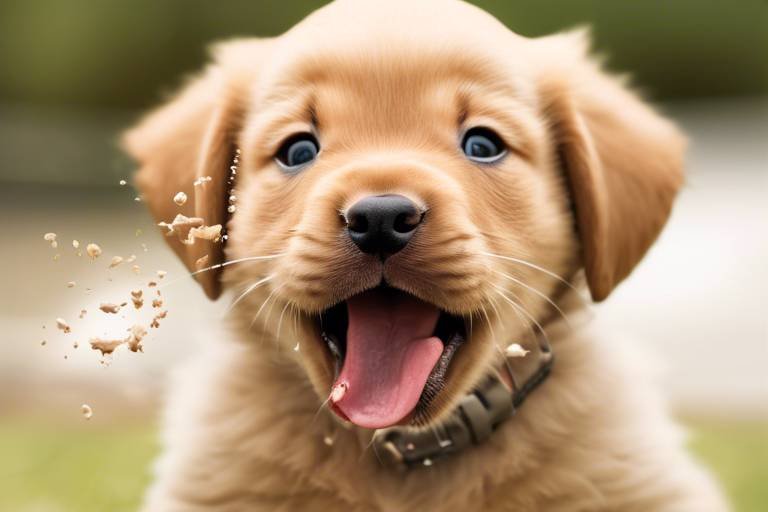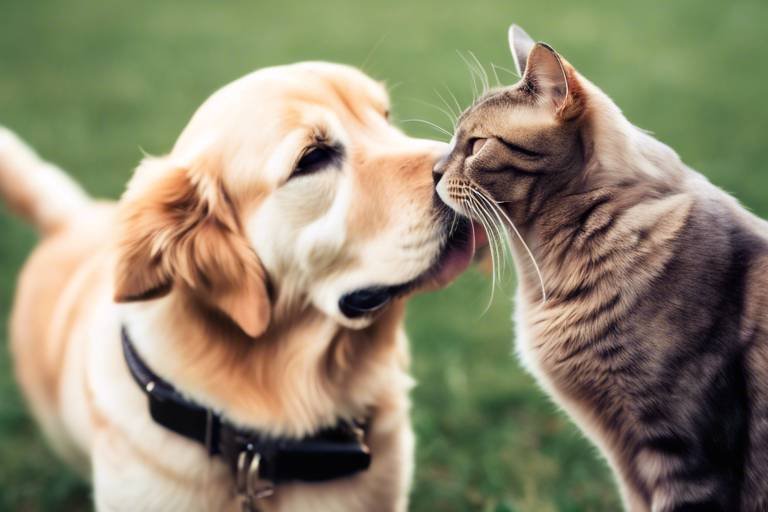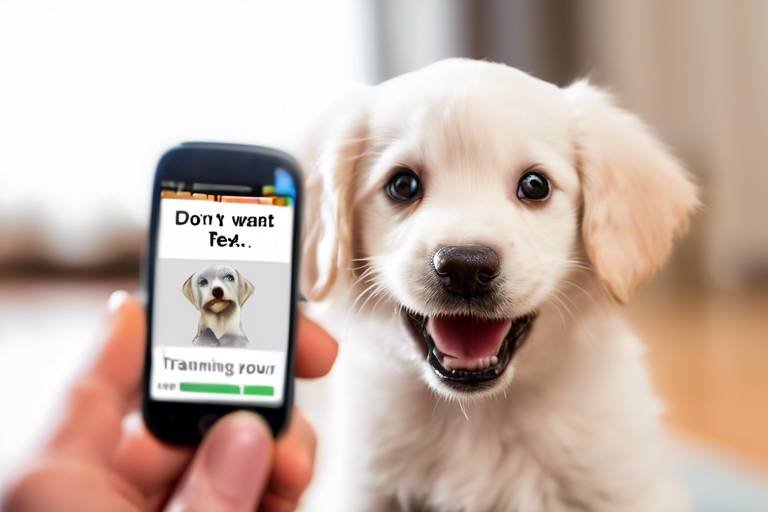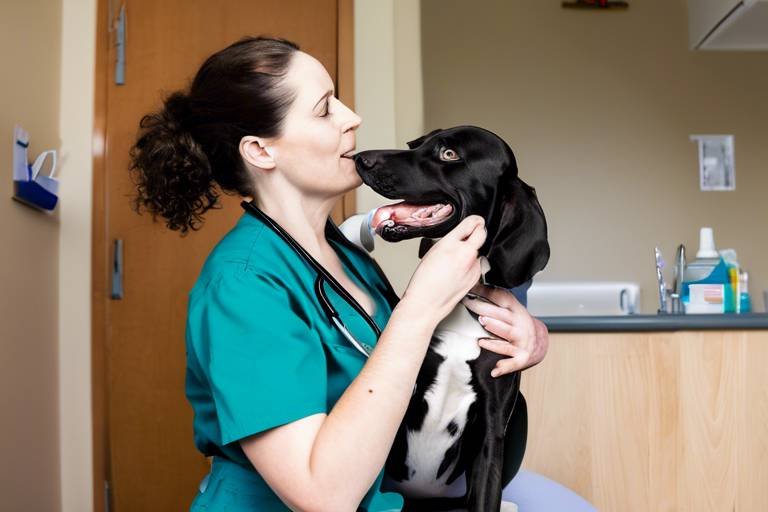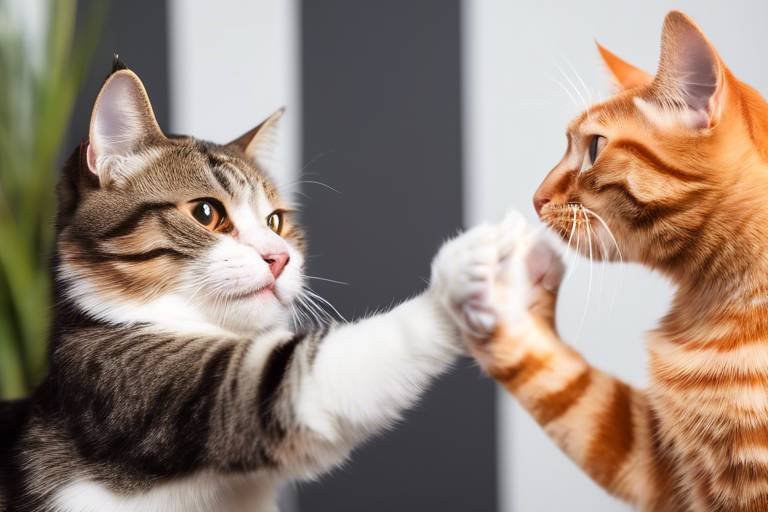How to Address Excessive Chewing in Puppies
Excessive chewing in puppies can be a real challenge for new pet owners, but fear not! Understanding how to manage this behavior is key to ensuring your furry friend develops into a well-adjusted adult dog. Puppies are naturally inclined to chew, and while it may seem like they're on a mission to destroy your favorite shoes or furniture, there's often a deeper reason behind their actions. In this article, we will explore effective strategies to manage and reduce excessive chewing behaviors, ensuring a healthy and happy development for your puppy.
Puppies chew for various reasons, and understanding these motivations is essential for addressing the behavior effectively. One of the primary reasons puppies chew is teething. Just like human babies, puppies go through a teething phase where their gums are sore and uncomfortable. Chewing helps relieve some of that discomfort. However, chewing can also stem from boredom or a desire to explore their environment. Puppies are naturally curious creatures, and they often use their mouths to investigate the world around them. By recognizing these motivations, you can better manage their chewing habits and promote positive behaviors.
To tackle excessive chewing, it’s crucial to identify what items your puppy is targeting. Are they going after your favorite pair of shoes? Or perhaps the corner of your couch? Recognizing these triggers is the first step in teaching them appropriate chewing habits. By understanding what your puppy finds irresistible, you can create a tailored approach to redirect their behavior. For instance, if your puppy is fixated on chewing your furniture, it might be time to invest in some enticing chew toys to lure them away from the couch.
Certain situations or items may provoke excessive chewing in puppies. Here are some common triggers to watch out for:
- Teething Phase: During this time, puppies experience discomfort, leading to increased chewing. Providing suitable chew toys can help alleviate their discomfort and redirect their chewing tendencies.
- Boredom and Anxiety: Puppies left alone for long periods can become bored or anxious, leading to destructive chewing. Understanding your puppy’s emotional state can guide you in offering appropriate mental and physical stimulation.
Redirecting your puppy’s chewing behavior involves providing alternatives and reinforcing positive habits. When you catch your puppy chewing on something they shouldn’t, gently redirect them to an appropriate chew toy. It's important to praise them when they choose the right item. This positive reinforcement helps them learn what is acceptable to chew on. Additionally, consider incorporating training sessions that focus on commands like "leave it" or "no" to further guide their behavior.
Selecting the right chew toys is crucial for your puppy's chewing needs. Not all toys are created equal, and it's important to consider factors such as safety, durability, and engagement level. Look for toys that are specifically designed for puppies, as they are often softer and easier on their developing teeth. Remember, the right chew toy can make all the difference in preventing destructive chewing!
Understanding which materials are safe for chew toys helps prevent health issues. Opting for non-toxic, durable materials is essential for your puppy's safety and enjoyment. Avoid toys with small parts that could pose a choking hazard, and steer clear of items made from harmful substances. When in doubt, always check the labels and choose products from reputable brands.
Interactive toys can provide mental stimulation, reducing the likelihood of excessive chewing. These toys keep your puppy engaged and help channel their energy positively. Puzzle toys, for example, can challenge your puppy and keep them entertained for hours. By incorporating these toys into your puppy's routine, you can significantly decrease their urge to chew on inappropriate items.
Creating a structured routine for your puppy can minimize boredom and anxiety, which are often linked to excessive chewing. A consistent daily schedule that includes playtime, training, and relaxation can help your puppy feel secure and content. Puppies thrive on routine, and knowing what to expect can alleviate their stress levels.
Incorporating regular exercise into your puppy's routine can help expend excess energy, reducing the likelihood of destructive chewing. A tired puppy is a happy puppy! Aim for daily walks, play sessions, or even trips to the dog park. Physical activity is key to a well-behaved puppy, and it also strengthens your bond with them.
Designating specific times for play can keep your puppy engaged and reduce their urge to chew on inappropriate items. Consistent playtime not only provides physical exercise but also stimulates their mind. Plus, it’s a great way to reinforce your relationship and teach them commands in a fun, interactive way.
Q: How can I tell if my puppy is chewing out of boredom?
A: If your puppy is left alone for long periods and begins to chew destructively, it’s likely boredom. Look for signs of restlessness or frustration, and try increasing their exercise and playtime.
Q: What types of chew toys are best for teething puppies?
A: Soft rubber toys, frozen chew toys, or specially designed teething toys can help soothe sore gums while providing an appropriate outlet for chewing.
Q: Is it okay to scold my puppy for chewing on the wrong items?
A: Instead of scolding, redirect your puppy to an appropriate chew toy. Positive reinforcement is more effective in teaching them what is acceptable to chew.
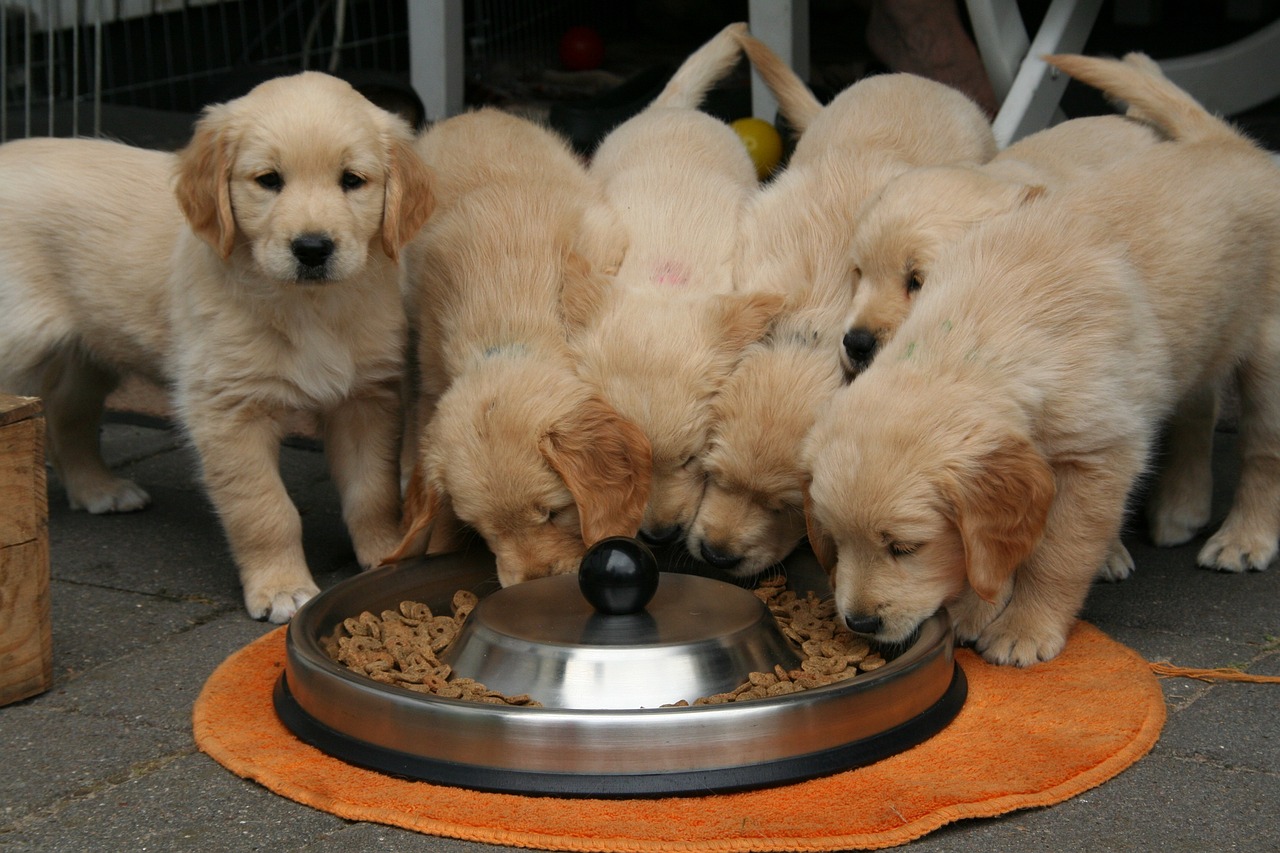
Understanding Puppy Chewing
Puppies are naturally curious creatures, and their world is full of exciting new things to explore. One of the most common ways they do this is through chewing. But why do puppies chew so much? Understanding the motivations behind this behavior is crucial for any puppy owner. Chewing serves several important purposes in a puppy's life, including teething relief, exploration, and even stress relief. It’s like a toddler discovering the world by putting everything into their mouth, only in this case, it’s your favorite pair of shoes!
First and foremost, let’s talk about teething. Just like human babies, puppies go through a teething phase where their gums are sore and uncomfortable. This phase typically occurs between three to six months of age. During this time, they will instinctively chew on various objects to alleviate the discomfort. Providing them with appropriate chew toys can help soothe their gums and redirect their chewing habits away from your furniture.
Another reason puppies chew is boredom. Puppies are energetic and need plenty of stimulation. If they don’t have enough to keep them engaged, they may turn to chewing as an outlet for their pent-up energy. This can lead to destructive behavior, where they might chew on your shoes, electrical cords, or even furniture. Think of it like a child who, left alone with nothing to do, starts drawing on the walls!
Lastly, anxiety can also play a significant role in excessive chewing. Puppies can feel anxious due to various reasons, such as being left alone for extended periods or changes in their environment. Chewing can act as a coping mechanism for them, providing comfort in stressful situations. Understanding these emotional triggers is essential for any pet parent looking to foster a well-adjusted puppy.
In summary, addressing excessive chewing in puppies requires a comprehensive understanding of their motivations. By recognizing the reasons behind their chewing, you can take proactive steps to guide them towards more appropriate chewing habits. Whether it's providing the right toys for teething, engaging them with stimulating activities, or alleviating their anxiety, you can help your puppy navigate this crucial stage of their development.
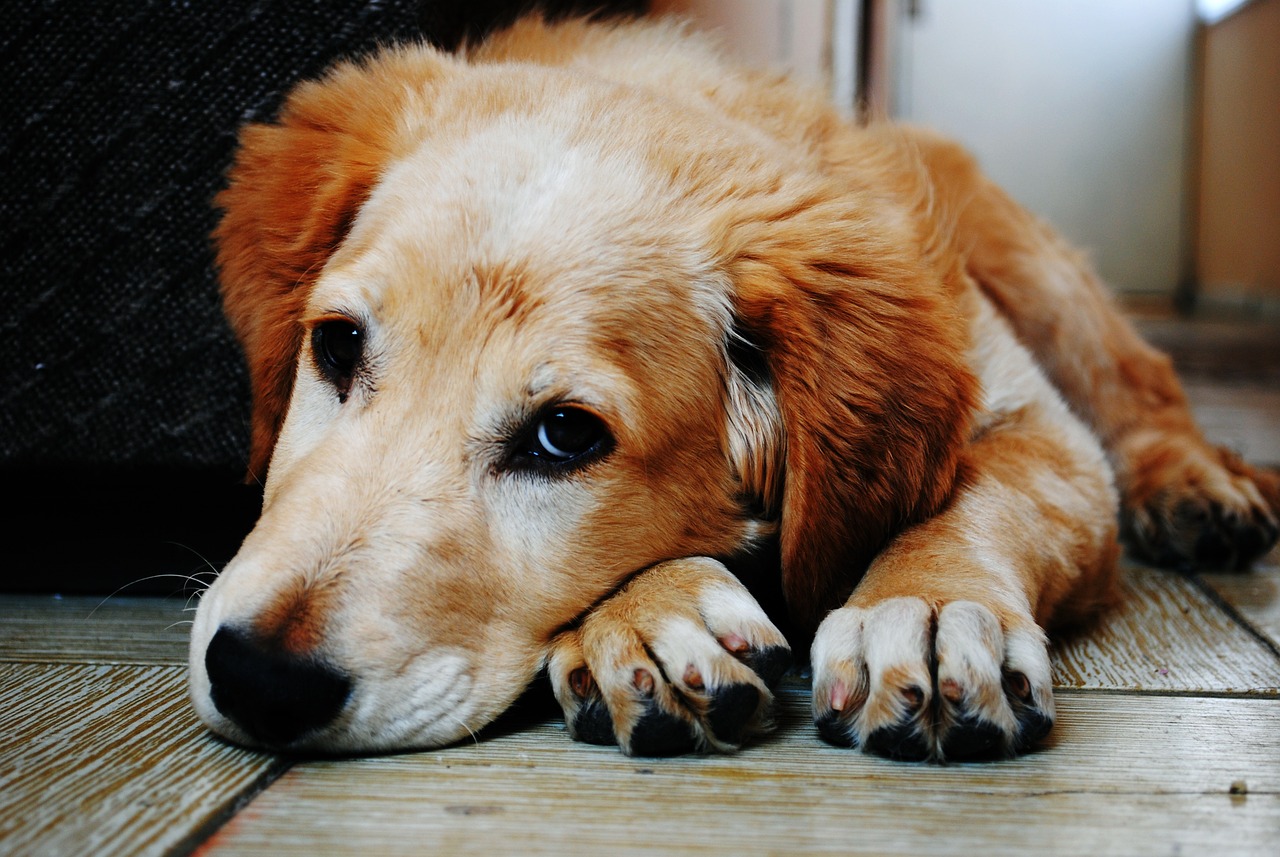
Identifying Problematic Chewing
Identifying problematic chewing in your puppy is a crucial step toward fostering positive behaviors and ensuring a harmonious home environment. As a puppy parent, it’s essential to understand that not all chewing is created equal. Some items might be harmless, while others could lead to serious issues, both for your belongings and your furry friend’s health. So, how do you pinpoint what your puppy is chewing excessively? Start by observing their behavior closely and taking note of the items they gravitate towards.
One effective method is to create a chewing log for your puppy. This log can help track their chewing habits, including the time of day, specific items they target, and the context in which the chewing occurs. For example, does your puppy chew more when they’re left alone, or is it more frequent during playtime? By keeping a record, you can identify patterns that may indicate boredom, anxiety, or the need for teething relief.
Here are some common items that puppies tend to chew excessively:
- Shoes and clothing
- Furniture and household items
- Electrical cords
- Houseplants
- Personal belongings, like bags or backpacks
By recognizing these triggers, you can take proactive measures to redirect their attention. For instance, if your puppy seems particularly interested in your shoes, it might be time to invest in some engaging chew toys that can satisfy that urge without damaging your belongings. Remember, the goal is not to scold your puppy for their natural instincts but to guide them toward appropriate chewing habits.
Another important aspect of identifying problematic chewing is understanding the emotional state of your puppy. Puppies often chew out of boredom or anxiety, so consider their daily routine. Are they getting enough physical activity? Are they left alone for extended periods? Addressing these underlying issues can significantly reduce excessive chewing behaviors.
In summary, identifying problematic chewing involves careful observation and understanding of your puppy’s motivations. By keeping a log, recognizing common triggers, and addressing their emotional needs, you can effectively redirect their chewing habits and promote a happier, healthier puppy.
Q: How can I tell if my puppy's chewing is excessive?
A: If your puppy is chewing items that are not designated chew toys, especially if they cause damage or pose a risk to their health, it may be considered excessive. Monitoring their behavior and keeping a log can help you identify patterns.
Q: What should I do if my puppy chews on electrical cords?
A: It’s essential to puppy-proof your home by securing or covering electrical cords. Additionally, redirect their attention to safe chew toys when you catch them in the act.
Q: Are there specific toys recommended for teething puppies?
A: Yes! Look for toys specifically designed for teething puppies, made from soft yet durable materials that can provide relief without damaging their teeth.
Q: How much exercise does my puppy need to prevent boredom-related chewing?
A: Puppies generally need about 30 minutes to 2 hours of exercise daily, depending on their breed and age. Regular walks, playtime, and mental stimulation are key to keeping them engaged.
Common Chewing Triggers
When it comes to our playful puppies, understanding the reasons behind their chewing habits is essential. Puppies are naturally curious creatures, and their chewing can often be traced back to specific triggers. By identifying these triggers, you can take proactive measures to redirect their behavior. Here are some common reasons why your puppy might be chewing excessively:
- Teething Discomfort: Just like human babies, puppies go through a teething phase that can be uncomfortable. As their baby teeth fall out and adult teeth come in, they may chew to alleviate the discomfort. This is a natural part of their development, but it can lead to some destructive habits if not managed properly.
- Boredom: Puppies are bundles of energy, and if they don't have enough to occupy their minds, they might turn to chewing as a way to entertain themselves. Just as we might fidget with objects when bored, puppies need stimulation to keep their minds engaged.
- Exploration: Puppies explore the world through their mouths. Everything is new and exciting to them, and chewing is a way for them to learn about their environment. Unfortunately, this can lead them to chew on items that are not meant for them, like shoes or furniture.
- Anxiety: Just like humans, puppies can experience anxiety. Whether it's due to separation from their owners or unfamiliar environments, anxious puppies may resort to chewing as a coping mechanism. This behavior can become problematic if not addressed.
By recognizing these common triggers, you can tailor your approach to managing your puppy's chewing habits. For instance, during the teething phase, providing appropriate chew toys can make a world of difference. Similarly, ensuring your puppy has plenty of physical exercise and mental stimulation can help curb boredom and anxiety, ultimately leading to healthier chewing habits.
Teething Phase
The teething phase in puppies is akin to a rollercoaster ride—full of ups and downs, excitement, and a bit of discomfort. Just like human babies, puppies go through a significant teething period where their baby teeth fall out and adult teeth come in. This natural process can lead to increased chewing as they seek relief from the soreness and discomfort that often accompanies teething. Imagine having a nagging toothache and finding relief by gnawing on something—this is precisely what your puppy is experiencing!
During this phase, it's vital to provide your puppy with appropriate chew toys that can help soothe their gums. Opt for toys that are specifically designed for teething puppies, as they are typically softer and more forgiving on tender gums. A great way to gauge whether a toy is suitable is to consider the material; rubber toys, for example, are often durable yet gentle enough for teething pups. Here's a quick reference table to help you choose the right toys:
| Type of Toy | Benefits | Examples |
|---|---|---|
| Rubber Toys | Durable and gentle on teeth | Kong Classic, Nylabone |
| Soft Plush Toys | Comforting and cuddly | Petstages Puppy Cuddle Pal |
| Frozen Chew Toys | Soothes sore gums | Frozen carrots, ice cubes in chew toys |
Additionally, you might want to consider freezing some of these toys or even offering frozen fruits and vegetables like carrots or apples (without seeds) to provide extra relief. Just make sure to supervise your puppy while they enjoy these treats to prevent any choking hazards. By giving your puppy the right tools to handle their teething discomfort, you not only help them cope with the pain but also redirect their chewing tendencies away from your favorite shoes or furniture.
Remember, patience is key during this phase. Puppies might chew more than usual, and it can be frustrating, but understanding that this behavior is entirely natural can help you remain calm. Consistently offering suitable alternatives and reinforcing positive chewing habits will pave the way for a well-adjusted adult dog. So, as you navigate through this teething phase, think of it as an investment in your puppy's future—one where they learn to chew appropriately and develop healthy habits!
Boredom and Anxiety
Puppies, much like young children, are bundles of energy and curiosity. When their days are filled with monotony or they feel anxious, they often resort to chewing as a way to cope. Imagine being stuck in a room with nothing to do—wouldn't you start fiddling with the nearest object? That's how your puppy feels when boredom sets in. Chewing becomes a form of entertainment, a way to pass the time, and unfortunately, it can lead to destructive behaviors.
Understanding the emotional state of your puppy is crucial in addressing excessive chewing. If your furry friend is left alone for long periods or is not provided with enough mental stimulation, they may chew on furniture, shoes, or even walls out of sheer boredom. Additionally, anxiety can manifest in similar ways; a puppy might chew to soothe themselves during stressful situations, such as loud noises, unfamiliar environments, or separation from their owner.
To combat boredom and anxiety, consider implementing a variety of engaging activities into your puppy's daily routine. Here are some effective strategies:
- Interactive Play: Spend quality time playing with your puppy using toys that encourage interaction. Games like fetch or tug-of-war can significantly reduce their boredom and keep them entertained.
- Training Sessions: Short and fun training sessions not only teach your puppy new commands but also provide mental stimulation. Incorporating tricks or agility training can be both rewarding and entertaining for them.
- Socialization: Exposing your puppy to different environments, people, and other dogs can help alleviate anxiety. Socialization is key in making your puppy feel secure and less likely to chew out of fear or stress.
By recognizing and addressing the signs of boredom and anxiety in your puppy, you can help redirect their chewing habits towards more appropriate behaviors. Remember, a well-stimulated puppy is a happy puppy, and they are far less likely to resort to destructive chewing when they have plenty of engaging activities to keep them busy.
Q: How can I tell if my puppy is chewing out of boredom or anxiety?
A: Signs of boredom may include excessive chewing on household items, while anxiety might present as destructive chewing during stressful situations. Observing your puppy's behavior and the context in which they chew can help determine the cause.
Q: What are some safe chew toys for puppies?
A: Look for toys made from non-toxic materials that are specifically designed for puppies. Rubber toys, rope toys, and soft plush toys are often safe and engaging options.
Q: How much exercise does my puppy need to prevent boredom?
A: Puppies typically need at least 30 minutes to 2 hours of exercise each day, depending on their breed and energy level. Regular walks, playtime, and mental stimulation are essential for their well-being.
Q: Can I train my puppy to stop chewing on inappropriate items?
A: Yes! Positive reinforcement training can help your puppy learn which items are appropriate to chew on. Redirect their attention to suitable toys and reward them for making the right choices.
Redirecting Chewing Behavior
Redirecting your puppy's chewing behavior is not just about stopping them from munching on your favorite shoes or furniture; it’s about teaching them what is acceptable and what isn’t. Think of it as guiding them through a maze where they can only take certain paths. The first step in this process is to provide alternatives that are both safe and engaging. When your puppy starts to chew on something inappropriate, gently redirect their attention to a designated chew toy. This can be a fun and interactive way to teach them the difference between what they can and cannot chew.
One effective strategy is to make the appropriate chew toys more enticing. You can do this by using puppy-safe flavors or even stuffing them with treats. This way, your puppy will associate the chew toy with positive experiences, making it more likely that they will choose it over your furniture. Also, consider using toys that make noise or have different textures; these can keep your puppy engaged for longer periods, reducing the urge to chew on other items.
Consistency is key in this training process. Whenever you catch your puppy in the act of chewing something they shouldn’t, calmly say “no” and redirect them to their chew toy. It’s crucial to remain patient and persistent, as puppies are still learning about their environment. Over time, they will start to understand that chewing on their toys is not only acceptable but is also a lot more fun than chewing on your belongings.
Additionally, reinforcing positive behavior plays a significant role in redirecting chewing habits. Whenever your puppy chooses to chew on their toy instead of your shoe, shower them with praise and perhaps a small treat. This positive reinforcement will encourage them to repeat the behavior. You can also create a reward system where your puppy earns points for every time they chew on their toys, which can be exchanged for a special treat or extra playtime. This not only keeps them occupied but also strengthens your bond.
Lastly, consider the emotional and physical needs of your puppy. A well-exercised puppy is less likely to engage in destructive chewing. Incorporate regular play sessions and mental stimulation activities into their daily routine. This can include puzzle toys that challenge their minds or interactive games that require them to think. By keeping their minds and bodies active, you’ll find that they are less likely to resort to chewing out of boredom or anxiety. Remember, it’s all about creating a balanced environment that promotes healthy chewing habits.
- What should I do if my puppy ignores their chew toys?
Try different types of toys, as puppies have varying preferences. You might also want to engage them in play with the toys to spark their interest. - How can I tell if my puppy is chewing due to anxiety?
If your puppy is chewing excessively and seems restless or is showing signs of distress, it might be anxiety. Consider consulting with a vet or a dog trainer for tailored advice. - Is it okay to use negative reinforcement to stop chewing?
Negative reinforcement can sometimes create fear or anxiety. It’s generally more effective to use positive reinforcement to encourage good behavior.
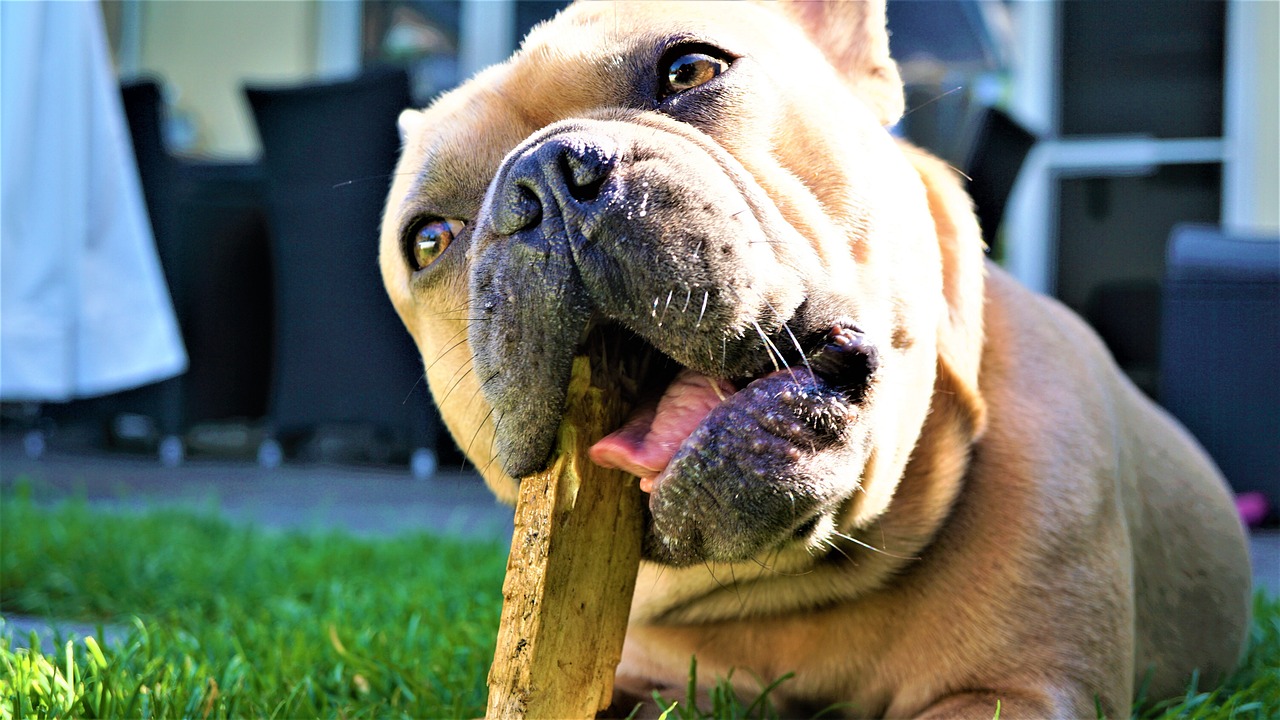
Choosing Appropriate Chew Toys
When it comes to your puppy's chewing habits, selecting the right chew toys can make all the difference. Puppies are naturally curious and love to chew, but not all toys are created equal. Choosing appropriate chew toys is essential not only for keeping your puppy entertained but also for ensuring their safety and promoting healthy chewing behaviors. So, what should you look for in a chew toy? Let's break it down!
First and foremost, you want to consider the material of the chew toys. Look for toys made from non-toxic and durable materials. This ensures that your puppy can chew safely without the risk of ingesting harmful substances. For instance, rubber and nylon are excellent choices as they are both sturdy and safe. Avoid toys that contain small parts that could be chewed off and swallowed, as this can pose a choking hazard. To help you visualize, here’s a quick comparison of common chew toy materials:
| Material | Safety | Durability |
|---|---|---|
| Rubber | Non-toxic | High |
| Nylon | Non-toxic | High |
| Rawhide | Can be harmful | Medium |
| Plastic | Varies | Low |
Additionally, consider your puppy's size and breed when choosing toys. A small toy might be perfect for a tiny pup, but it could pose a choking risk for a larger breed. Similarly, larger toys designed for big dogs might not provide enough stimulation for a smaller dog. It's crucial to find a size that is appropriate for your furry friend to ensure they can chew comfortably and safely.
Another factor to think about is the type of chew toy. There are various options available, including interactive toys, which can keep your puppy engaged for longer periods. These toys often have compartments for treats or are designed to make sounds, enticing your pup to play and chew. On the other hand, teething toys can provide relief during those uncomfortable teething phases, helping to soothe sore gums while also redirecting their chewing behavior. The key is to offer a variety of toys to keep things interesting for your puppy.
Incorporating chew toys into your puppy's daily routine can also help in managing their chewing habits. Encourage your puppy to chew on their toys by engaging with them during playtime. Toss the toy around, or play tug-of-war to make the experience more enjoyable. This not only reinforces positive chewing behavior but also strengthens your bond with your puppy, making them feel loved and secure.
Ultimately, the right chew toys can turn what might be a troublesome habit into a healthy, enjoyable activity for your puppy. By paying attention to material safety, size, and type of toy, you'll be well on your way to fostering a happy and well-adjusted pup. Remember, a well-chewed toy is a happy puppy!
- What are the best materials for chew toys? Look for non-toxic materials like rubber and nylon.
- How do I know if a chew toy is safe? Ensure it is durable, free of small parts, and made from safe materials.
- Can I give my puppy rawhide toys? Rawhide can pose choking risks and digestive issues; consult your vet for recommendations.
- How often should I replace chew toys? Regularly inspect toys for wear and tear, replacing them as needed to ensure safety.
Safe Materials
This article explores effective strategies to manage and reduce excessive chewing behaviors in puppies, ensuring a healthy and happy development for your furry friend.
Puppies chew for various reasons, including teething, boredom, and exploration. Understanding these motivations is essential for addressing the behavior effectively and promoting positive chewing habits.
Recognizing what items your puppy is chewing excessively can help you redirect their behavior. Identifying these triggers is the first step in teaching them appropriate chewing habits.
Certain situations or items may provoke excessive chewing in puppies. Identifying these triggers will help you create a tailored approach to discourage the behavior.
During the teething phase, puppies experience discomfort, leading to increased chewing. Providing suitable chew toys can help alleviate their discomfort and redirect their chewing tendencies.
Boredom or anxiety can lead puppies to chew destructively. Understanding your puppy’s emotional state can guide you in offering appropriate mental and physical stimulation.
Redirecting your puppy’s chewing behavior involves providing alternatives and reinforcing positive habits. This section discusses practical strategies for redirecting their attention to appropriate items.
Selecting the right chew toys is crucial for your puppy's chewing needs. This section covers factors to consider when choosing toys that are safe and engaging for your puppy.
When it comes to choosing chew toys, should be your top priority. Puppies are naturally curious and will often chew on anything they can get their paws on, so ensuring that the materials used in their toys are non-toxic and durable is essential for their health and safety. Here are some materials to look for:
- Rubber: Durable and flexible, rubber toys can withstand aggressive chewing and are often designed to bounce, making playtime even more engaging.
- Natural fibers: Toys made from cotton or jute can be safe for chewing, but be sure they are free from harmful dyes or chemicals.
- Wood: Certain types of wood, like bamboo, can be a safe option, but avoid treated wood that may contain harmful substances.
On the other hand, it's equally important to avoid certain materials that can pose risks. For instance, toys made from plastic can break easily and create sharp edges, while cheap rubber may contain harmful chemicals that can be dangerous if ingested. Always opt for reputable brands that prioritize safety in their manufacturing processes.
In summary, investing in chew toys made from safe materials not only protects your puppy's health but also enhances their play experience. Remember, the right toys will keep them entertained while steering them away from your favorite shoes and furniture!
Creating a structured routine for your puppy can minimize boredom and anxiety, which are often linked to excessive chewing. This section discusses the importance of consistency in training.
Incorporating regular exercise into your puppy's routine can help expend excess energy, reducing the likelihood of destructive chewing. Physical activity is key to a well-behaved puppy.
Designating specific times for play can keep your puppy engaged and reduce their urge to chew on inappropriate items. Consistent playtime strengthens your bond and promotes positive behavior.
Q: How can I tell if a chew toy is safe for my puppy?
A: Look for toys made from non-toxic materials, check for durability, and ensure there are no small parts that could be swallowed. Always supervise your puppy during playtime.
Q: What should I do if my puppy continues to chew on furniture?
A: Redirect their attention to appropriate chew toys, reinforce positive behavior with treats, and ensure they have enough mental and physical stimulation to reduce boredom.
Q: How often should I replace my puppy's chew toys?
A: Regularly inspect chew toys for wear and tear. Replace them when they show signs of damage to prevent choking hazards.
Interactive Toys
Interactive toys are a game-changer when it comes to managing your puppy's chewing habits. These toys not only keep your furry friend entertained, but they also provide essential mental stimulation that can significantly reduce the urge to chew on inappropriate items. Think of them as a puzzle for your pup; they engage their brain, challenge their problem-solving skills, and help channel their energy in a positive direction. When puppies are mentally stimulated, they are less likely to resort to destructive behaviors out of boredom or anxiety.
When selecting interactive toys, consider options that encourage your puppy to think and engage. For example, toys that dispense treats or require your puppy to figure out how to access a reward can keep them occupied for hours. Not only does this provide a fun challenge, but it also rewards them for their efforts, reinforcing positive behavior. Here are some popular types of interactive toys that can be beneficial:
- Puzzle Toys: These toys often have compartments for treats that your puppy must figure out how to access. They come in various difficulty levels, so you can choose one that matches your puppy's skills.
- Fetch Toys: Toys that can be thrown and retrieved not only provide physical exercise but also engage your puppy's natural instincts. Look for ones that squeak or make noise to add an extra layer of excitement.
- Chew Toys with a Twist: Some chew toys are designed with interactive elements, like hidden compartments for treats, making them more engaging than standard chew toys.
Moreover, incorporating interactive toys into your puppy's daily routine can create a structured environment where they feel secure and entertained. Rotate the toys regularly to keep their interest piqued and encourage exploration. Just like kids, puppies can get bored with the same toys, so introducing new challenges can keep their minds sharp and their chewing habits in check.
In addition to providing entertainment, interactive toys can also strengthen your bond with your puppy. Engaging in playtime together fosters trust and affection, making your puppy more receptive to training. So, the next time you notice your puppy reaching for your favorite shoes or furniture, consider investing in some interactive toys. They could be the key to a happier, healthier, and less destructive puppy!
Q: How do I know if a toy is safe for my puppy?
A: Always look for toys made from non-toxic materials and ensure they are the appropriate size for your puppy to avoid choking hazards. Check for any small parts that could be easily chewed off.
Q: How often should I rotate my puppy's toys?
A: Rotating toys every few days can keep your puppy engaged and prevent boredom. It’s like giving them new toys without the expense!
Q: Can interactive toys really help with chewing issues?
A: Yes! Interactive toys provide mental stimulation and can keep your puppy entertained, reducing the likelihood of destructive chewing due to boredom or anxiety.
Q: What should I do if my puppy still chews on inappropriate items?
A: If your puppy continues to chew on things they shouldn't, consider redirecting their attention to appropriate chew toys and reinforcing positive behavior with praise and treats.
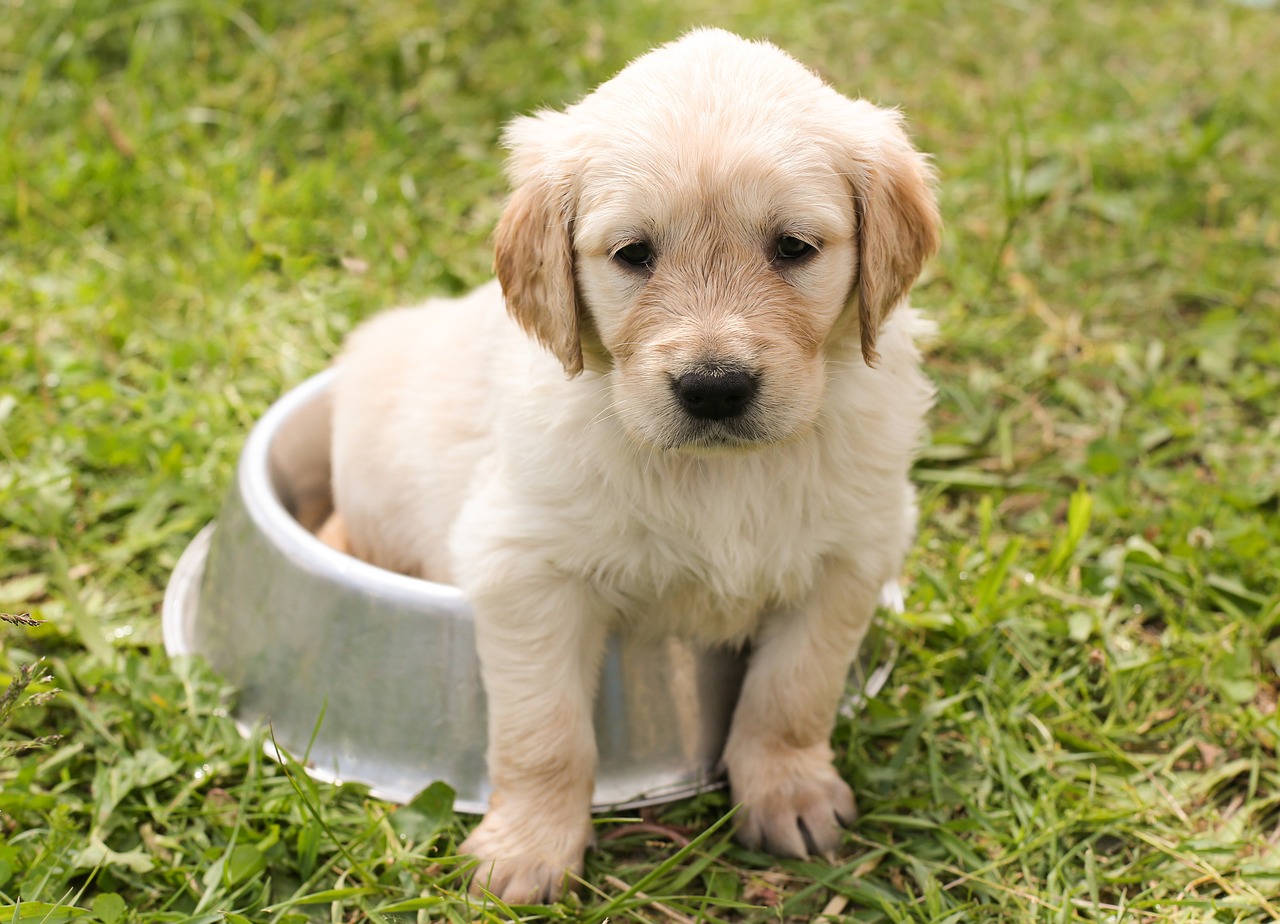
Establishing a Routine
Creating a structured routine for your puppy is not just a good idea; it's a game changer! A well-established routine can significantly minimize issues like boredom and anxiety, which are often at the root of excessive chewing. Just like humans thrive on routine, so do our furry friends. Imagine how chaotic life would be without a daily schedule! Puppies benefit from knowing what to expect throughout their day, and this predictability helps them feel secure and happy.
When you think about a routine, consider incorporating various elements that cater to your puppy's physical, mental, and emotional needs. Regular feeding times, play sessions, and walks can all contribute to a balanced lifestyle. For instance, if your puppy knows that they will have a walk after breakfast, they will be less likely to chew on your favorite shoes while waiting for their outing. This structure not only helps with their behavior but also strengthens the bond between you and your pup.
To give you an idea of how to establish a routine, here’s a simple daily schedule you might consider:
| Time | Activity |
|---|---|
| 7:00 AM | Feeding |
| 7:30 AM | Morning Walk |
| 8:00 AM | Playtime with Toys |
| 12:00 PM | Afternoon Nap |
| 1:00 PM | Training Session |
| 5:00 PM | Evening Walk |
| 6:00 PM | Dinner |
| 7:00 PM | Interactive Play |
| 9:00 PM | Wind Down and Relaxation |
This schedule is just a guideline; feel free to adjust it based on your puppy's needs and your lifestyle. The key is to keep it consistent. Dogs are creatures of habit, and they thrive when they know what comes next. Over time, you'll notice that your puppy becomes more relaxed and less prone to destructive behaviors, including excessive chewing.
Moreover, incorporating regular exercise into your puppy's routine is essential. A tired puppy is a well-behaved puppy! Daily walks and play sessions not only help expend excess energy but also promote healthy physical development. Think of it as a way to "wear them out" so they have less energy to channel into chewing on things they shouldn’t.
Lastly, don't forget about scheduled playtime! Designating specific times for play can keep your puppy engaged and reduce their urge to chew on inappropriate items. Consistent playtime strengthens your bond and promotes positive behavior. Remember, the more time you invest in structured activities, the more you’ll see the benefits in your puppy’s behavior. So, grab those toys, head outside, and make every moment count!
- How long should I walk my puppy each day? Generally, puppies need about 30 minutes to 2 hours of exercise daily, depending on their age and breed.
- What are the best chew toys for puppies? Look for toys made from durable, non-toxic materials that are specifically designed for teething puppies.
- How can I tell if my puppy is bored? Signs of boredom can include excessive chewing, digging, barking, or destructive behavior.
- Is it normal for puppies to chew on furniture? Yes, puppies often chew on furniture as a way to explore their environment and alleviate teething discomfort.
Regular Exercise
This article explores effective strategies to manage and reduce excessive chewing behaviors in puppies, ensuring a healthy and happy development for your furry friend.
Puppies chew for various reasons, including teething, boredom, and exploration. Understanding these motivations is essential for addressing the behavior effectively and promoting positive chewing habits.
Recognizing what items your puppy is chewing excessively can help you redirect their behavior. Identifying these triggers is the first step in teaching them appropriate chewing habits.
Certain situations or items may provoke excessive chewing in puppies. Identifying these triggers will help you create a tailored approach to discourage the behavior.
During the teething phase, puppies experience discomfort, leading to increased chewing. Providing suitable chew toys can help alleviate their discomfort and redirect their chewing tendencies.
Boredom or anxiety can lead puppies to chew destructively. Understanding your puppy’s emotional state can guide you in offering appropriate mental and physical stimulation.
Redirecting your puppy’s chewing behavior involves providing alternatives and reinforcing positive habits. This section discusses practical strategies for redirecting their attention to appropriate items.
Selecting the right chew toys is crucial for your puppy's chewing needs. This section covers factors to consider when choosing toys that are safe and engaging for your puppy.
Understanding which materials are safe for chew toys helps prevent health issues. Opting for non-toxic, durable materials is essential for your puppy's safety and enjoyment.
Interactive toys can provide mental stimulation, reducing the likelihood of excessive chewing. These toys keep your puppy engaged and help channel their energy positively.
Creating a structured routine for your puppy can minimize boredom and anxiety, which are often linked to excessive chewing. This section discusses the importance of consistency in training.
Incorporating into your puppy's routine is not just a good idea; it's essential! Think of exercise as a magic pill that can transform your puppy's behavior from chaotic to calm. Just like humans, puppies need to burn off energy, and if they don’t, that energy can manifest in less desirable ways, like chewing on your favorite shoes or the furniture.
How much exercise does your puppy need? Well, it often depends on their age, breed, and energy level. For instance, a high-energy breed like a Border Collie might require more vigorous physical activity compared to a laid-back Bulldog. A good rule of thumb is to aim for at least 30 minutes to 2 hours of exercise each day, broken up into multiple sessions. Here are some fun ideas to get your pup moving:
- Daily Walks: A simple walk around the neighborhood can do wonders.
- Play Fetch: This classic game is a puppy favorite and great for burning energy.
- Agility Training: Set up a mini obstacle course in your backyard!
- Dog Parks: Socialization at a dog park can provide both exercise and mental stimulation.
Moreover, regular exercise not only helps in reducing excessive chewing but also strengthens the bond between you and your puppy. Just imagine your puppy happily wagging their tail, looking up at you with gratitude after a fun play session. It’s heartwarming, isn’t it? So, lace up those sneakers and get moving!
Designating specific times for play can keep your puppy engaged and reduce their urge to chew on inappropriate items. Consistent playtime strengthens your bond and promotes positive behavior.
Q: How can I tell if my puppy is chewing out of boredom?
A: If your puppy is chewing on items they shouldn't, like furniture or shoes, and they seem to have a lot of pent-up energy, they might be bored. Providing more toys and interactive play can help.
Q: What are the signs of teething in puppies?
A: Signs of teething include chewing more than usual, drooling, or seeming uncomfortable when chewing on hard objects. Providing appropriate chew toys can help ease their discomfort.
Q: How can I encourage my puppy to use their chew toys?
A: Make the chew toys more appealing by playing with them together. You can also try smearing a little peanut butter on them or using toys that dispense treats to attract their attention.
Scheduled Playtime
Designating specific times for play is not just a good idea; it's essential for your puppy's mental and physical well-being. Think of scheduled playtime as a mini-adventure for your furry friend. When you establish a routine, your puppy begins to anticipate these moments, leading to excitement and a sense of stability. Just like children thrive on routine, puppies do too! A well-planned play schedule can help reduce their urge to chew on inappropriate items, as they will have an outlet for their energy.
During these play sessions, you can engage in various activities that stimulate both their mind and body. For instance, playing fetch or tug-of-war can be incredibly rewarding for your puppy. Not only does it offer physical exercise, but it also strengthens the bond between you and your pet. Remember, the key is to make these sessions fun and engaging. Utilize different toys and activities to keep things fresh; this will prevent boredom and keep your puppy guessing what’s next!
Moreover, the duration and frequency of these play sessions can vary based on your puppy's age, breed, and energy levels. Generally, aim for at least two to three play sessions a day, each lasting around 15 to 30 minutes. This approach ensures that your puppy remains physically active and mentally stimulated throughout the day. Here’s a quick breakdown of how you might structure your puppy's playtime:
| Time of Day | Activity | Duration |
|---|---|---|
| Morning | Fetch in the backyard | 20 minutes |
| Afternoon | Tug-of-war with a rope toy | 15 minutes |
| Evening | Interactive puzzle toys | 30 minutes |
In addition to structured playtime, be sure to incorporate spontaneous play opportunities throughout the day. If you notice your puppy getting restless or starting to chew on something inappropriate, take a moment to engage them with a quick game or a new toy. This not only redirects their focus but also reinforces the idea that play is a positive outlet for their energy. Ultimately, by establishing a consistent play routine, you are setting your puppy up for success, ensuring they grow into a well-adjusted, happy adult dog.
- How long should playtime be for my puppy?
Playtime should typically last between 15 to 30 minutes, depending on your puppy’s age and energy level. Aim for two to three sessions a day. - What types of toys are best for playtime?
Interactive toys, fetch balls, and tug toys are great options. Ensure they are safe and appropriate for your puppy’s size and chewing habits. - Can I over-exercise my puppy?
Yes, it’s important to monitor your puppy during play. Signs of over-exertion include excessive panting, lethargy, or reluctance to continue playing. - What if my puppy still chews on inappropriate items?
Consistency is key. Redirect their attention to appropriate toys and reinforce positive behavior with praise or treats.
Frequently Asked Questions
-
Why do puppies chew so much?
Puppies chew for a variety of reasons, including teething discomfort, boredom, and the natural instinct to explore their environment. Chewing helps them relieve pain during the teething phase and satisfies their curiosity about the world around them.
-
How can I tell if my puppy's chewing is excessive?
If your puppy is chewing on inappropriate items like furniture, shoes, or electrical cords, it's a sign of excessive chewing. Additionally, if the chewing leads to destruction or injury, it's crucial to address the behavior promptly.
-
What are some effective ways to redirect my puppy's chewing?
To redirect your puppy's chewing, provide them with appropriate chew toys and engage them in interactive play. Reinforce positive chewing habits by praising them when they choose their toys over household items.
-
What types of chew toys are best for puppies?
Look for chew toys made from safe, non-toxic materials that are durable and suitable for your puppy's size. Interactive toys that stimulate your puppy's mind can also help reduce excessive chewing by keeping them occupied.
-
How can I establish a routine to help with my puppy's chewing?
Creating a structured routine that includes regular exercise and scheduled playtime can significantly reduce boredom and anxiety in puppies. A well-exercised puppy is less likely to engage in destructive chewing behaviors.
-
Is it normal for puppies to chew on everything?
Yes, it's normal for puppies to explore their world through chewing. However, it's important to guide them towards appropriate items and teach them what is acceptable to chew on.
-
When should I be concerned about my puppy's chewing?
If your puppy's chewing leads to injuries, persistent anxiety, or if they start chewing on harmful items, it's time to seek advice from a veterinarian or a professional dog trainer.

